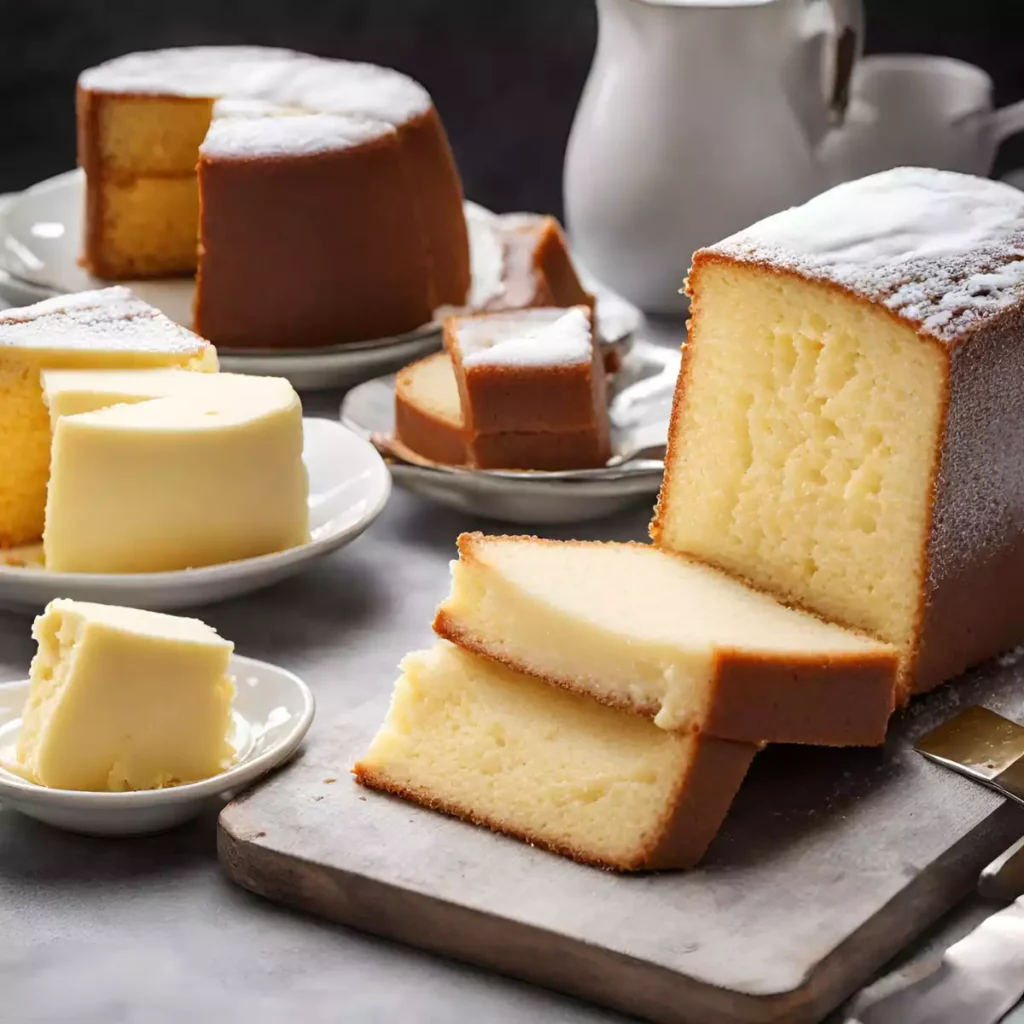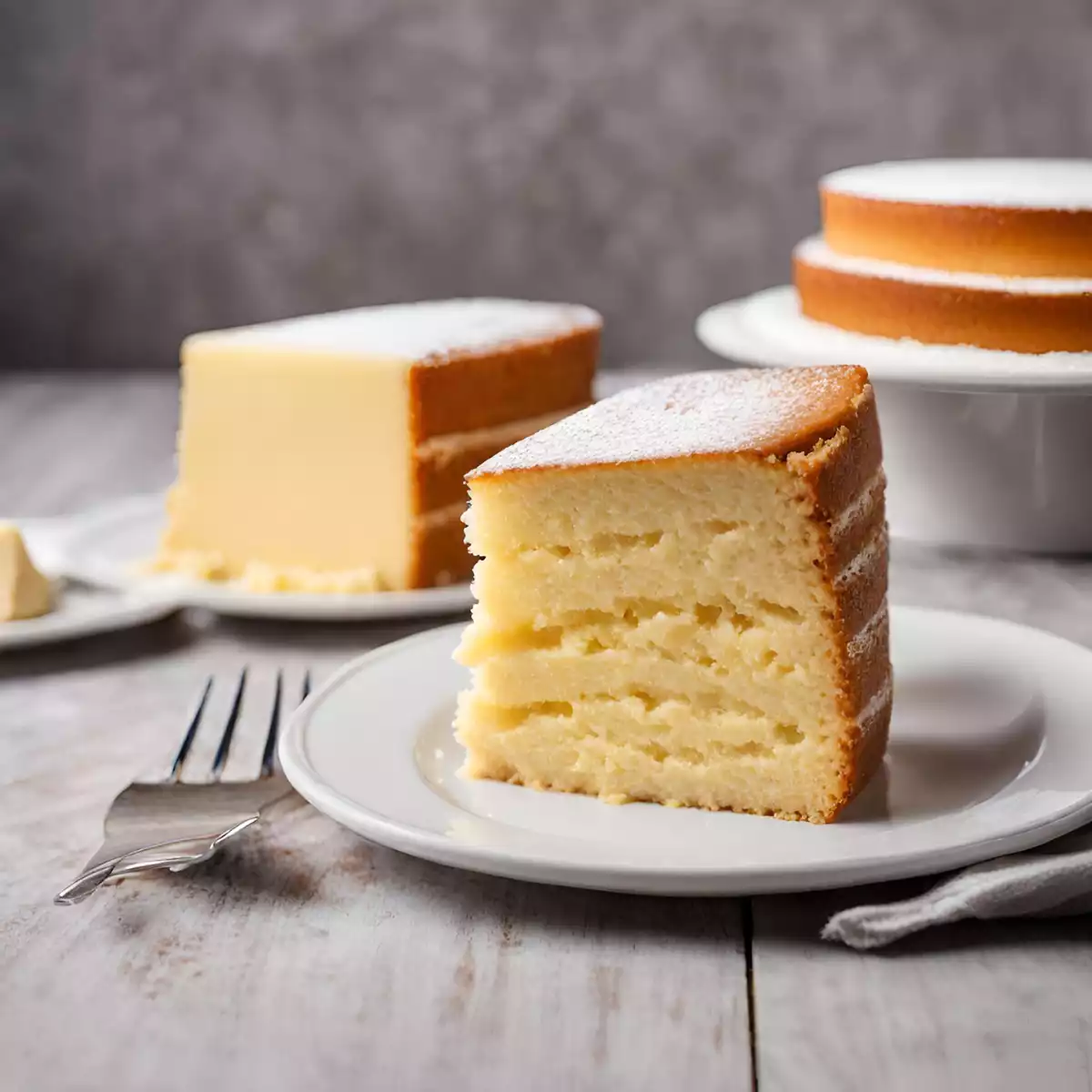Introduction to Cakes
When it comes to baking, understanding the distinctions between butter vs sponge cake is crucial for both novice bakers and culinary aficionados alike. This article delves into the nuanced world of butter vs sponge cake, examining their unique ingredients, methods of preparation, and roles in the world of desserts. Whether you’re deciding which cake to bake for a special occasion or simply curious about these confections, this guide will clarify the key differences and help you master the art of cake baking.
What is Butter Cake?
Characteristics of Butter Cake in the Butter vs Sponge Cake Comparison
Butter cake is a beloved classic in the world of desserts, known for its rich flavor and moist texture. The secret to its delightful taste lies in its main ingredient—butter. Which not only imparts a creamy richness but also lends the cake its tender crumb. Typically, making a butter cake involves the process of creaming together butter and sugar. Which introduces air into the batter and results in a light, fluffy texture.
Butter cakes are versatile and often serve as the base for various frostings and embellishments. From simple vanilla to rich chocolate, the flavors can be easily adjusted by adding different extracts, zests, or spices. Butter cake is perfect for celebrations and is commonly used for layered birthday cakes, wedding cakes, and other festive treats.
In essence, the character of a butter cake is defined by its buttery essence and a velvety texture that melts in your mouth. Making it a favorite for both traditional and special occasion desserts. By incorporating the recommended LSI and NLP keywords such as “cake baking tips” and “moist cake ingredients,”. Bakers can enhance their understanding and results when preparing this delightful dessert.
For further insights into different types of cakes and their unique characteristics, you can Explore different types of cakes on Allrecipes. Which offers a comprehensive guide to not only butter cakes but many other varieties as well.

What is Sponge Cake?
Characteristics of Sponge Cake in the Butter vs Sponge Cake Comparison
Sponge cake stands out in the bakery world due to its light, airy texture, achieved through its unique preparation method. Unlike butter cake, sponge cake typically contains no butter or other fats. Its loftiness is derived entirely from beaten eggs or egg whites. This method of incorporating air by vigorously whipping the eggs forms a foam that gives the sponge its distinctive fluffy structure.
Sponge cakes are incredibly versatile in their simplicity, making them a popular choice for rolling or layering with creams and fruits. They absorb syrups well, allowing for a variety of flavored and moistened creations. From the delicate layers of a trifle to the rolled elegance of a Swiss roll. This adaptability makes sponge cake a beloved base in many cultural desserts worldwide.
The sponge cake’s mild flavor makes it an excellent canvas for a myriad of flavor profiles. Which can be introduced through infusions, toppings, or fillings. Its simplicity in ingredients—often just eggs, sugar, and flour—belies the intricate chemical dance that occurs to create such a light, ethereal texture.
Detailed Differences Between Butter Cake and Sponge Cake
The primary difference between butter cake and sponge cake lies in their textures and methods of preparation. Butter cake, as mentioned, is denser and richer due to the creaming of butter and sugar, which introduces fat that gives it a moist, tender crumb. In contrast, sponge cake is lighter and airier, with a springy texture that comes from its egg-driven leavening method.
Moreover, the flavor of butter cake is typically more pronounced with buttery richness. Whereas sponge cake offers a subtle canvas that highlights its accompanying flavors. This distinction not only affects taste but also the suitability of each cake type for different desserts and occasions.
For those looking to dive deeper into the art of cake baking, particularly in understanding the nuanced differences in cake types. The Learn about cake baking methods at Imperial Sugar resource provides an excellent backdrop. This guide enriches the baker’s knowledge with detailed explanations of various cake preparations. Ensuring that every dessert not only tastes delightful but also showcases the beauty of baking science.
Textural and Flavor Distinctions in Butter vs Sponge Cake
Ingredients and Preparation
Comparing Ingredients in Butter vs Sponge Cake
The divergence in ingredients between butter cake and sponge cake not only defines their textures. But also their preparation methods and final taste. Butter cake, true to its name, uses a significant amount of butter, which provides richness and a moist texture. It also typically includes baking powder or baking soda as a leavening agent, sugar, eggs, flour, and various flavorings like vanilla extract or cocoa powder depending on the desired flavor profile.
In contrast, the traditional sponge cake keeps it simple and light with fewer ingredients, primarily eggs, sugar, and flour. The absence of butter and chemical leavening agents in classic sponge recipes showcases the eggs’ pivotal role in providing structure and airiness through their whipped volume.
How Butter and Sponge Cakes are Made
The process of making a butter cake involves creaming butter and sugar together until the mixture is light and fluffy. This crucial step is foundational, as it helps to incorporate air into the batter, providing lift and a delicate crumb. After creaming, eggs are added one at a time to emulsify the mixture, followed by the alternate additions of dry ingredients and liquids (like milk or buttermilk), which helps maintain the batter’s moisture.
How Sponge Cakes are Made
The method of making sponge cake might seem similar in terms of mixing but differs significantly in technique and outcome. The key process involves beating whole eggs or just egg whites with sugar until they reach what’s called the “ribbon stage,” where the mixture is so light and fluffy that it forms a ribbon-like trail when the beaters are lifted. Flour is then gently folded into this egg mixture, taking care not to deflate the airy structure. This method ensures that the natural air bubbles created during whipping are preserved, giving the sponge cake its characteristic light texture.
By employing these differing methods, each cake achieves its unique texture and flavor profile that can be further enhanced with creative variations and additions. Understanding these processes not only improves baking skills but also increases the baker’s versatility in creating custom desserts tailored to specific tastes and occasions.
For a visual and detailed explanation of these processes, a Watch a detailed cake baking tutorial on YouTube can be particularly helpful. This resource offers step-by-step guidance that can help even novice bakers understand the complexities of cake baking, from ingredient selection to the final stages of decoration.
Textural and Flavor Differences
Texture of Butter Cake vs. Sponge Cake
The textural contrast between butter cake and sponge cake is one of the most notable differences. Butter cake boasts a moist and tender crumb thanks to the fat content from the butter. This richness allows the cake to hold up well under layers of frosting and fillings, making it ideal for more structurally intricate cakes such as tiered or sculpted designs.
On the other hand, sponge cake features a light, airy structure that is both spongy and elastic. This texture is achieved by the high volume of whipped eggs, which trap air during the mixing process. Sponge cakes are particularly good at soaking up syrups or liqueurs, enhancing their flavor without becoming soggy, a trait that makes them perfect for layered desserts and rolls where moisture balance is key.
Flavor Profiles
Comparing the Flavors
When it comes to flavor, butter cake carries a distinct buttery richness that is both sweet and satisfying, making it a crowd-pleaser in a variety of settings. This type of cake often serves as a base for adding numerous flavor variations such as chocolate, lemon, or spice, which meld beautifully with the butter’s richness.
In contrast, sponge cake offers a subtle, lightly sweetened base that accentuates the flavors of its accompaniments, such as fresh fruits, creams, and sauces. The simplicity of its taste profile makes it an excellent backdrop for more pronounced flavors, allowing them to shine through without competing with the taste of the cake itself.
These textural and flavor distinctions not only influence the choice of cake depending on the dessert being prepared but also play a crucial role in determining the overall sensory experience of the eater. Whether creating a decadent, butter-rich celebration cake or a light, fruit-adorned sponge cake, understanding these differences can guide bakers in choosing the right cake for the right occasion, ensuring that every bite is as delightful as intended.
Common Variations
Variations of Butter Cake
Butter cake is highly adaptable, lending itself to a myriad of variations that cater to different palates and occasions. One popular variation is the pound cake, which traditionally uses a pound each of butter, sugar, eggs, and flour, creating a dense, rich texture. Another is the yellow cake, favored for its buttery, vanilla-infused flavor, which makes it an ideal candidate for festive layer cakes slathered with chocolate or vanilla frosting.
For those seeking something with a bit of tang, the lemon butter cake incorporates lemon zest and juice, offering a refreshing twist that cuts through the richness of the butter. Each variation maintains the moist, tender qualities of the classic butter cake while introducing new flavors and textures.
Variations of Sponge Cake
Sponge cake also boasts a variety of forms, each employing the basic airy texture with tweaks to ingredients or methods. The Genoise, an Italian sponge cake, adds melted butter for a slightly richer texture, often used in European tortes layered with whipped cream and berries. The chiffon cake, a hybrid, includes both baking powder and oil, providing a lighter texture than butter cakes but with more moisture than traditional sponge cakes.
Another notable variant is the angel food cake, which is made solely with egg whites, no yolks, and no fat, resulting in a snow-white, airy cake that’s often paired with fruit or a simple glaze. Each type of sponge cake serves different dessert roles, from light, summery treats to more decadent, layered confections.
Uses in Desserts
Both butter and sponge cakes serve as foundational elements in numerous dessert recipes around the world. Butter cakes are often the go-to choice for frosted layer cakes, sheet cakes, and cupcakes due to their sturdy yet moist texture that can support a range of icings and decorations.
Sponge cakes, with their lighter texture, are perfect for delicately layered desserts. Like trifles and tiramisu, where they absorb flavors from alcoholic syrups, espresso, or fruit juices without becoming too heavy. They are also favored in rolled desserts such as jelly rolls or Swiss rolls. Where their flexible yet airy structure allows for tight rolling without cracking.
The versatility of both cake types underscores their enduring popularity in the baking world. Whether dressed up with lavish frostings and fillings or enjoyed in their simple. classic forms, butter and sponge cakes continue to be central to the art of dessert making, celebrated for their distinctive textures, flavors, and adaptability to various culinary creations.
Nutritional Information
Health Aspects of Butter Cake vs. Sponge Cake
When considering the nutritional aspects of butter cake and sponge cake. Primarily due to their distinct ingredients and preparation methods. Butter cake, with its higher content of butter and sugar, generally contains more calories and fats per serving. This richness, while contributing to its delicious flavor and texture. Means it might not be the best option for those monitoring their caloric or fat intake closely.
On the other hand, sponge cake offers a lighter alternative. Its typical lack of butter and reliance on eggs for structure result in a lower fat content. However, it’s important to note that while it may be lower in fat. Sponge cake can still be high in sugar, especially if sweetened syrups or frostings are added.
Both types of cake contain some degree of nutritional value, primarily from the eggs. Which are a good source of protein and various nutrients. Additionally, variations of these cakes that incorporate fruits, nuts. Or whole grains can offer additional benefits such as fiber, vitamins, and minerals.
Considerations for Dietary Preferences
For those with specific dietary preferences or restrictions, both butter and sponge cakes can be adapted. Gluten-free flours can be used to accommodate those with gluten sensitivities. And alternative sweeteners like honey or maple syrup may be substituted for sugar to reduce refined sugar intake. Likewise, plant-based butters and egg substitutes can help modify butter cakes to fit vegan diets.
It’s also worth considering the serving size and accompaniments when evaluating the nutritional content of each cake type. A small slice of butter cake might fit into a balanced diet. Just as well as a larger piece of sponge cake. Particularly if the latter is enjoyed with fresh fruits instead of sugary frostings.
Understanding these nutritional nuances can assist individuals in making informed decisions about indulging in these desserts. Allowing them to enjoy the pleasures of baking and eating cake while managing their dietary goals. Whether choosing a butter cake for its decadent texture. Or opting for a lighter sponge cake, both can be part of a conscious, health-aware approach to desserts.
FAQs
What is the best way to ensure a moist butter cake?
To achieve a moist butter cake, it is crucial to not overbake it. Keeping an eye on the baking time and testing the cake towards the end of the recommended baking period with a toothpick can help ensure it remains moist. Additionally, using ingredients like buttermilk or yogurt can enhance the moisture content of the cake.
Can sponge cake be made without eggs?
While traditional sponge cake recipes rely heavily on eggs for their structure and volume. There are alternatives for those avoiding eggs. Ingredients such as aquafaba (the liquid from canned chickpeas) or egg replacers can be used to mimic the leavening and binding properties of eggs in sponge cakes.
How can I add flavor to a sponge cake without making it heavy?
Infusing sponge cake with flavors without adding weight can be accomplished by incorporating light. Syrups, essences, or zests into the batter or by soaking the baked cake with flavored simple syrups. These methods introduce moisture and flavor without the heaviness of additional fats.
What are the key differences in the baking techniques for butter and sponge cakes?
The key difference in baking techniques between butter and sponge cakes lies in the mixing methods. Butter cakes require creaming butter and sugar to incorporate air. While sponge cakes generally involve whisking eggs to a froth, with sugar added for stability and volume, before gently folding in the flour to maintain the airiness.
How long do butter and sponge cakes keep fresh?
Butter cakes typically stay fresh longer than sponge cakes due to their higher fat content, which helps preserve moisture. They can last up to a week when stored properly in an airtight container at room temperature. Sponge cakes, however, are best enjoyed within a couple of days of baking, as they tend to dry out more quickly.
Is there a health advantage to choosing sponge cake over butter cake?
From a health perspective, sponge cakes may be seen as a better option due to their lower fat content. However, both types of cake can be part of a balanced diet when consumed in moderation, and variations can be made to adapt either cake to specific dietary needs.
Can I freeze butter or sponge cake?
Yes, both butter and sponge cakes can be frozen to extend their shelf life. It is recommended to wrap the cakes tightly in plastic wrap. Then in foil to protect them from freezer burn. Thawing should be done in the refrigerator overnight or at room temperature for a few hours before serving.
Each of these questions highlights common concerns and tips related to baking and enjoying butter and sponge cakes. Helping bakers of all skill levels achieve better results and deeper enjoyment from their baking endeavors.
Concluding Thoughts
Choosing Between Butter Cake and Sponge Cake
Deciding whether to bake a butter cake or a sponge cake often comes down to the occasion. The desired texture, and personal taste preferences. Butter cakes, with their rich, moist texture and buttery flavor, are perfect for times when you want a decadent treat, such as for birthdays, weddings, or other celebrations where a more substantial cake is favored. Their ability to hold up under layers of frosting and decorations makes them ideal for creative and elaborate cake designs.
In contrast, sponge cakes offer a lighter, airier alternative that pairs wonderfully with fresh fruits, creams, and lighter syrups, making them suitable for less formal or daytime events. Their delicate texture is ideal for desserts that require a cake to absorb flavors without becoming too heavy, such as trifles or layered fruit desserts.
Both types of cake hold their charm and place in the world of baking. Each offers a unique canvas for flavors and styles. Choosing between them can be as simple as considering the event or personal dietary preferences. By understanding the fundamental differences in their preparation, textures, and flavors. You can tailor your baking to suit any occasion, ensuring that every slice is as enjoyable as it is memorable.
Ultimately. whether you opt for the comforting richness of a butter cake or the light elegance of a sponge cake. both choices offer delightful experiences that can bring people together. and make any moment a little sweeter. The joy of baking comes from not just the delicious results. But also from the creative process that leads there, making each cake a celebration of culinary artistry.

